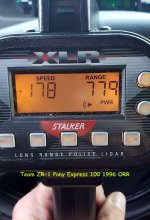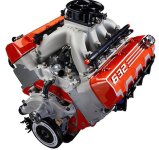teamzr1
Supporting vendor
It wasn't that long ago that the words "crate engine" were tainted by an element of shame.
What kind of hot rodder buys an engine that's already built? "A true gearhead builds his own engine" was the typical knee-jerk response, but ever since the arrival of Chevy's LS small-block engine a quarter-century ago, that has gradually changed.
LS crate engines are all the rage now, and when we look at the history of the LS small-block, we can see that a steady march of mechanical development along with the evolution of the engine's design brief has resulted in a tremendous jump in power.
It has also resulted in a proliferation of different versions—46 production variants in all, if we count Gen IV and Gen V—and their parts can't always be relied on to interchange.
The LS engine is best imagined as an evolving series of different small-block V-8 engines with some shared parts, the most critical components being the engine block and cylinder heads, followed by the camshaft/valvetrain, and rotating assembly.
As the aftermarket has adapted to changes made at the factory over the past 25 years, its focus has narrowed down the performance variants of the LS engine family such as the popular rectangle-port LS3/L92, helping hot rodders and engine builders target their performance efforts to the factory variants that pay the biggest dividends.
In some cases, the aftermarket has altered the basic LS design to make it more robust in some areas, a great example of this being Dart Machinery's LS Next block, which is different enough to the point that it technically isn't a Chevy LS engine any more.
To the uninitiated, parts ordering to build or finish an LS engine can seem like a secret language with a steep learning curve and a high out-of-pocket cost for getting it wrong.
Fortunately, you've come to the right place; if you appreciate really big horsepower and if you know the value of a dollar, these six LS crate engines are the most powerful units currently being produced and have the highest bang-for-the-buck.
BluePrint 625 hp/427 cu-in LS Retrofit Crate Engine Price: $11,999.99
BluePrint Engines is a bulk builder of crate engines and the company's focus is typically on modestly-priced high-value offerings that are widely sold as commodities at big-box outlets. With the company's BP4273LS 427 cu-in offering, however, BluePrint pulls out all the stops, with a new Chevy LS3/L92 block stuffed with a fully forged 427 cubic-inch rotating assembly (typically, this is 4.0000-inch bore x 4.125-inch stroke).
With a compression ratio of 11:1, it's a naturally aspirated combo that makes an honest 625 hp and 565 lb-ft of torque using a .624-inch lift hydraulic roller cam with 239/255 degrees duration at .050-inch lift and a set of BluePrint's proprietary 72cc chamber rectangle-port heads (2.165-/1.600-inch diameter valves).
The powerhouse crate engine comes fully assembled with an LS3 intake manifold, 87mm DBW throttle body and throttle pedal, balancer, 42 lb/hr injectors, coil packs, ECM (including calibration), and includes individual dyno testing and a 30-month/50,000-mile warranty.
BluePrint also offers versions of its 427 cubic-inch LS stroker crate engine with a high-end billet aluminum accessory drive set-up ($14,299, here), and an 800 hp Magnuson supercharged version (starting at $19,299 here), but the best price we found for the 625 hp version was offered through Classic Industries for $11,999.99. (We noted that the crate engine model number was off by one digit; the specs are otherwise the same, but you may want to put in a call before ordering as some of the details may be updated).
Chevrolet Performance 627 hp LSX 454 Crate Engine Price: $12,148.97
On its website, Chevrolet Performance says its LSX 454 crate engine (part No. 19355573) is big-block power for the 21st century, and at 627 hp (6,300 rpm) and 586 lb-ft (5,100 rpm) you can believe them. Our search dug up a number of storefronts that sell the LSX 454 crate engine, but Texas Speed is currently offering it for $12,148.97, so it may pay to shop around some. Like the BluePrint Engines' 625 hp/427 cu-in offering, the Chevy Performance LSX454 contains a fully-forged rotating assembly (11:1 compression, 4.185-inch bore x 4.125-inch stroke), but uses a Chevy Performance part No. 19260099 Bowtie Block, otherwise differentiated from a production LS7 block with its cast iron construction and extra beefcake in lower bulkhead areas.
Critically, the LSX 454 crate relies on a pair of as-cast 70cc LS7 production cylinder heads which feature CNC porting from the factory as well as 2.200-inch titanium intake valves and 1.610-inch diameter sodium-filled exhaust valves. Matched to the LS7 heads is a hydraulic roller cam with specs of .648-inch lift and 236/246 degrees duration at .050-inch valve lift.
Note that the Chevy Performance LSX454 is a partial long-block designed in large part for racers and specialty builders who often have class-specific limitations or space constraints; you will still need to pair it with the rectangle-port intake manifold, throttle body, injectors, and ECU of your choice.
Based most closely on the specs of the discontinued production LS7 (2006 to 2015), the LSX 454 differs in that it does not have the LS7's aluminum block, titanium connecting rods, intake, or dry-sump lube system, but it does have additional beef in the bottom end to handle a power adder such as nitrous oxide or a supercharger kit. This is an engine you'll need to customize to your liking, making each installed version different.
What kind of hot rodder buys an engine that's already built? "A true gearhead builds his own engine" was the typical knee-jerk response, but ever since the arrival of Chevy's LS small-block engine a quarter-century ago, that has gradually changed.
LS crate engines are all the rage now, and when we look at the history of the LS small-block, we can see that a steady march of mechanical development along with the evolution of the engine's design brief has resulted in a tremendous jump in power.
It has also resulted in a proliferation of different versions—46 production variants in all, if we count Gen IV and Gen V—and their parts can't always be relied on to interchange.
The LS engine is best imagined as an evolving series of different small-block V-8 engines with some shared parts, the most critical components being the engine block and cylinder heads, followed by the camshaft/valvetrain, and rotating assembly.
As the aftermarket has adapted to changes made at the factory over the past 25 years, its focus has narrowed down the performance variants of the LS engine family such as the popular rectangle-port LS3/L92, helping hot rodders and engine builders target their performance efforts to the factory variants that pay the biggest dividends.
In some cases, the aftermarket has altered the basic LS design to make it more robust in some areas, a great example of this being Dart Machinery's LS Next block, which is different enough to the point that it technically isn't a Chevy LS engine any more.
To the uninitiated, parts ordering to build or finish an LS engine can seem like a secret language with a steep learning curve and a high out-of-pocket cost for getting it wrong.
Fortunately, you've come to the right place; if you appreciate really big horsepower and if you know the value of a dollar, these six LS crate engines are the most powerful units currently being produced and have the highest bang-for-the-buck.
BluePrint 625 hp/427 cu-in LS Retrofit Crate Engine Price: $11,999.99
BluePrint Engines is a bulk builder of crate engines and the company's focus is typically on modestly-priced high-value offerings that are widely sold as commodities at big-box outlets. With the company's BP4273LS 427 cu-in offering, however, BluePrint pulls out all the stops, with a new Chevy LS3/L92 block stuffed with a fully forged 427 cubic-inch rotating assembly (typically, this is 4.0000-inch bore x 4.125-inch stroke).
With a compression ratio of 11:1, it's a naturally aspirated combo that makes an honest 625 hp and 565 lb-ft of torque using a .624-inch lift hydraulic roller cam with 239/255 degrees duration at .050-inch lift and a set of BluePrint's proprietary 72cc chamber rectangle-port heads (2.165-/1.600-inch diameter valves).
The powerhouse crate engine comes fully assembled with an LS3 intake manifold, 87mm DBW throttle body and throttle pedal, balancer, 42 lb/hr injectors, coil packs, ECM (including calibration), and includes individual dyno testing and a 30-month/50,000-mile warranty.
BluePrint also offers versions of its 427 cubic-inch LS stroker crate engine with a high-end billet aluminum accessory drive set-up ($14,299, here), and an 800 hp Magnuson supercharged version (starting at $19,299 here), but the best price we found for the 625 hp version was offered through Classic Industries for $11,999.99. (We noted that the crate engine model number was off by one digit; the specs are otherwise the same, but you may want to put in a call before ordering as some of the details may be updated).
Chevrolet Performance 627 hp LSX 454 Crate Engine Price: $12,148.97
On its website, Chevrolet Performance says its LSX 454 crate engine (part No. 19355573) is big-block power for the 21st century, and at 627 hp (6,300 rpm) and 586 lb-ft (5,100 rpm) you can believe them. Our search dug up a number of storefronts that sell the LSX 454 crate engine, but Texas Speed is currently offering it for $12,148.97, so it may pay to shop around some. Like the BluePrint Engines' 625 hp/427 cu-in offering, the Chevy Performance LSX454 contains a fully-forged rotating assembly (11:1 compression, 4.185-inch bore x 4.125-inch stroke), but uses a Chevy Performance part No. 19260099 Bowtie Block, otherwise differentiated from a production LS7 block with its cast iron construction and extra beefcake in lower bulkhead areas.
Critically, the LSX 454 crate relies on a pair of as-cast 70cc LS7 production cylinder heads which feature CNC porting from the factory as well as 2.200-inch titanium intake valves and 1.610-inch diameter sodium-filled exhaust valves. Matched to the LS7 heads is a hydraulic roller cam with specs of .648-inch lift and 236/246 degrees duration at .050-inch valve lift.
Note that the Chevy Performance LSX454 is a partial long-block designed in large part for racers and specialty builders who often have class-specific limitations or space constraints; you will still need to pair it with the rectangle-port intake manifold, throttle body, injectors, and ECU of your choice.
Based most closely on the specs of the discontinued production LS7 (2006 to 2015), the LSX 454 differs in that it does not have the LS7's aluminum block, titanium connecting rods, intake, or dry-sump lube system, but it does have additional beef in the bottom end to handle a power adder such as nitrous oxide or a supercharger kit. This is an engine you'll need to customize to your liking, making each installed version different.


